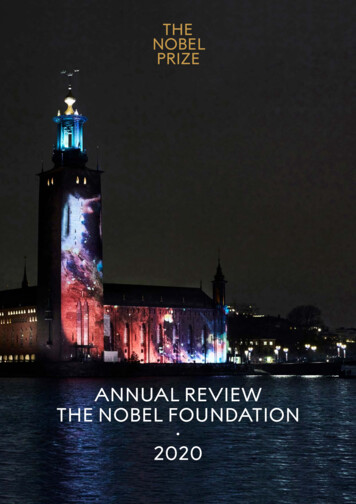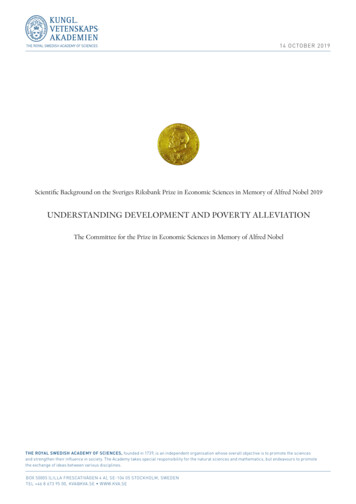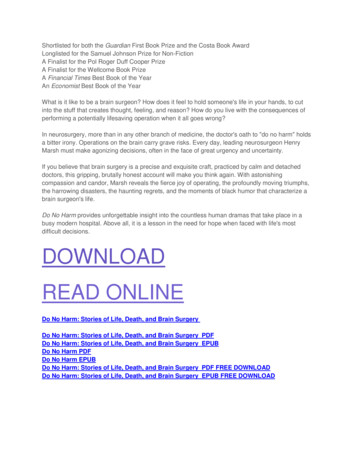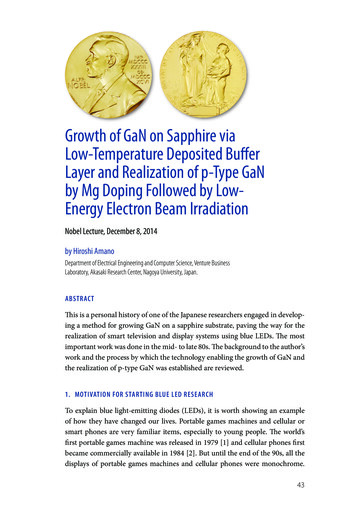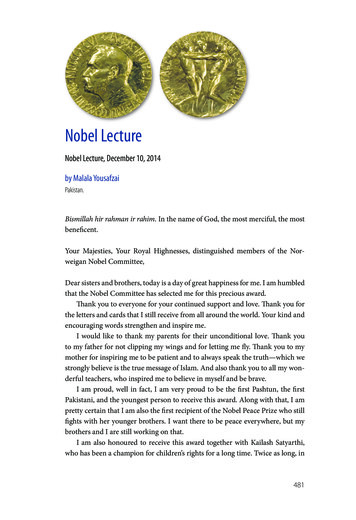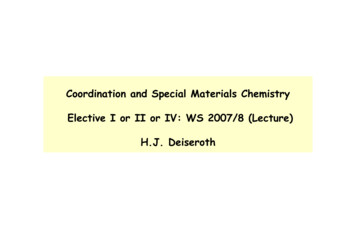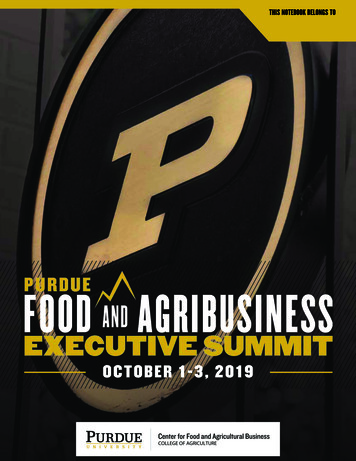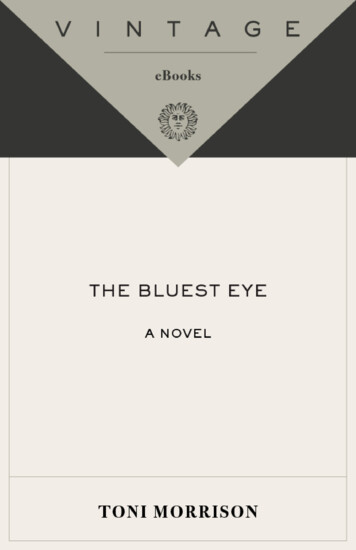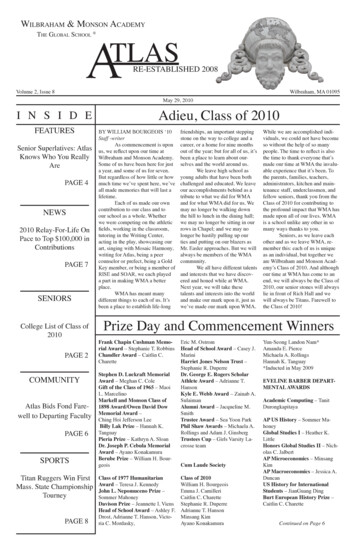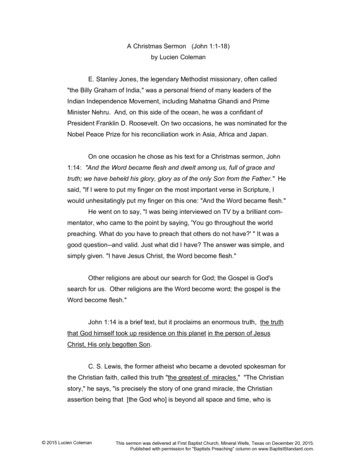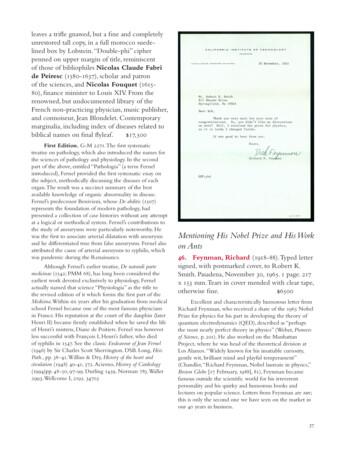
Transcription
leaves a trifle gnawed, but a fine and completelyunrestored tall copy, in a full morocco suedelined box by Lobstein. “Double-phi” cipherpenned on upper margin of title, reminiscentof those of bibliophiles Nicolas Claude Fabride Peiresc (1580-1637), scholar and patronof the sciences, and Nicolas Fouquet (161580), finance minister to Louis XIV. From therenowned, but undocumented library of theFrench non-practicing physician, music publisher,and connoiseur, Jean Blondelet. Contemporarymarginalia, including index of diseases related tobiblical names on final flyleaf. 17,500First Edition. G-M 2271. The first systematictreatise on pathology, which also introduced the names forthe sciences of pathology and physiology. In the secondpart of the above, entitled “Pathologia” (a term Fernelintroduced), Fernel provided the first systematic essay onthe subject, methodically discussing the diseases of eachorgan. The result was a succinct summary of the bestavailable knowledge of organic abnormality in disease.Fernel’s predecessor Benivieni, whose De abditis (1507)represents the foundation of modern pathology, hadpresented a collection of case histories without any attemptat a logical or methodical system. Fernel’s contributions tothe study of aneurysms were particularly noteworthy. Hewas the first to associate arterial dilatation with aneurysmand he differentiated true from false aneurysms. Fernel alsoattributed the cause of arterial aneuysms to syphilis, whichwas pandemic during the Renaissance.Although Fernel’s earlier treatise, De naturali partemedicinae (1542; PMM 68), has long been considered theearliest work devoted exclusively to physiology, Fernelactually named that science “Physiologia” as the title tothe revised edition of it which forms the first part of theMedicina. Within six years after his graduation from medicalschool Fernel became one of the most famous physiciansin France. His reputation at the court of the dauphin (laterHenri II) became firmly established when he saved the lifeof Henri’s mistress, Diane de Poitiers. Fernel was howeverless successful with François I, Henri’s father, who diedof syphilis in 1547. See the classic Endeavour of Jean Fernel(1946) by Sir Charles Scott Sherrington. DSB. Long, Hist.Path., pp. 38–41. Willius & Dry, History of the heart andcirculation (1948) 40-41, 372. Acierno, History of Cardiology(1994)pp. 48-50, 97-99. Durling 1459. Norman 785. Waller2993. Wellcome I, 2195. 34703Mentioning His Nobel Prize and His Workon Ants46. Feynman, Richard (1918-88). Typed lettersigned, with postmarked cover, to Robert K.Smith. Pasadena, November 30, 1965. 1 page. 217x 153 mm. Tears in cover mended with clear tape,otherwise fine. 6500Excellent and characteristically humorous letter fromRichard Feynman, who received a share of the 1965 NobelPrize for physics for his part in developing the theory ofquantum electrodynamics (QED), described as “perhapsthe most nearly perfect theory in physics” (Weber, Pioneersof Science, p. 201). He also worked on the ManhattanProject, where he was head of the theoretical division atLos Alamos. “Widely known for his insatiable curiosity,gentle wit, brilliant mind and playful temperament”(Chandler, “Richard Feynman, Nobel laureate in physics,”Boston Globe [17 February, 1988], 81), Feynman becamefamous outside the scientific world for his irreverentpersonality and his quirky and humorous books andlectures on popular science. Letters from Feynman are rare;this is only the second one we have seen on the market inour 40 years in business.
Feynman’s letter, written a few weeks after he had receivednotification of his Nobel award, was a response to a friend’snote of congratulations (we have not been able to furtheridentify the recipient). The letter reads as follows:Dear Bob, Thank you very much for your note ofcongratulations. So, you didn’t like my discussionson ants? Well, I received the prize for physics, so it islucky I changed fields. It was good to hear from you.Yours, Dick Feynman“Discussions on ants” refers to Feynman’s studies ofant behavior made while he was in graduate school atPrinceton and after he began teaching at the CaliforniaInstitute of Technology; he included an amusing accountof these ant studies in his autobiography, Surely You’reJoking, Mr. Feynman! One of Feynman’s investigations—onhow ants in an ant trail create a straight path betweentwo points—has some bearing on his work on quantumelectrodynamics. Feynman described this investigation inhis autobiography:One question that I wondered about was why theant trails look so straight and nice. The ants look asif they know what they’re doing, as if they have agood sense of geometry.Yet the experiments that Idid [at Princeton] to try to demonstrate their sense ofgeometry didn’t work. Many years later, when I wasat Caltech . . . some ants came out around the bathtub. . . I put some sugar on the other end of the bathtub. . . The moment the ant found the sugar, I picked upa colored pencil . . . and behind where the ant went Idrew a line so I could tell where his trail was. The antwandered a little bit wrong to get back to the hole, sothe line was quite wiggly, unlike a typical ant trail.When the next ant to find the sugar began to goback, I marked his trail with another color . . . hefollowed the first ant’s return trail back, rather thanhis own incoming trail. (My theory is that when anant has found some food, he leaves a much strongertrail than when he’s just wandering around.) Thissecond ant was in a great hurry and followed,pretty much, the original trail. But because he wasgoing so fast he would go straight out, as if he werecoasting, when the trail was wiggly. Often, as theant was “coasting,” he would find the trail again.Already it was apparent that the second ant’s returnwas slightly straighter. With successive ants the same“improvement” of the trail by hurriedly and carelessly“following” it occurred. I followed eight or ten antswith my pencil until their trails became a neat lineright along the bathtub (Feynman, pp. 95-96).The ants’ process of arriving at a straight path, as Feynmandescribed it, bears a strong similarity to Feynman’s conceptof how particles move in a straight line from point A to point B, a key part of his contribution to the theory ofquantum electrodynamics:Now, we ordinarily think of particles (such asphotons) as traveling in straight lines from A to B,but Feynman’s concept was that, in a sense, a particlefollows all possible paths, and it just so happens thatthe lengths of nearly straight paths are not verysensitive to slight variations of the path, so they allhave nearly identical lengths, meaning they havenearly the same phase, so their amplitudes add up. Onthe other hand, the lengths of the more convolutedpaths are more sensitive to slight variations in thepaths, so they have differing phases and tend to cancelout. The result is that the most probable path (by far)from A to B is the straight path (“Feynman’s Ants.”MathPages. Web. 12 Jan. 2011).Feynman, Surely You’re Joking, Mr. Feynman (1985). 4108447. Feynman, Richard (1918-88). Autographletter signed to Henri Corbière. N.p. [Pasadena],April 1970 (docketed “27/4/70” in recipient’shand). 1 page. 295 x 210 mm. Slight fraying atedges, but very good. 12,500Extraordinarily rare autograph letter from Feynman,who received a share of the 1965 Nobel Prize forphysics for his part in developing the theory of quantumelectrodynamics (QED), described as “perhaps the mostnearly perfect theory in physics” (Weber, Pioneers of Science,p. 201). Feynman mentions his work on QED in his letterto Corbière, a European autograph collector who had sentFeynman a list of questions about his scientific work andcareer; Feynman’s response, written on the same sheet,answers Corbière’s questions in order. Corbière askedFeynman the following:1. Where [sic] your scientific “debut” easy or difficult?2. Did means of living (another profession or aprivate income) enable you to make yourself knownin science? Or did you live solely through your workof laboratory?3. What work (or what discovery) made yourselfmore famous?Which do you consider your masterpiece?Feynman responded in his characteristically playful way:1. It was easy.2. All my income has been from scientific work.3. I have just written some papers about a subjectcalled “Quantum Electrodynamics” (which means theunified theory of atoms, light and electricity). Manypeople have read these so I guess that’s what makes
It was also called a thermionic valve, vacuum diode,kenotron, thermionic tube, or Fleming valve. . . .This invention is often considered to have been thebeginning of electronics, for this was the first vacuumtube. Fleming’s diode was used in radio receiversand radars for many decades afterwards, until it wassuperseded by solid state electronic technology morethan 50 years later (Wikipedia).Fleming’s invention paved the way for Lee DeForest andothers to perfect the broadcasting of wireless signals. 40296me “famous,” if I am. I do not have a masterpiece.But I like to work in physics.I thank you for your interest in me, it’s flattering.Richard P. Feynman40927Beginning of Electronics48. Fleming, John Ambrose (1849-1945).On the conversion of electric oscillations intocontinuous currents by means of a vacuumvalve. In Proc. Roy. Soc. 74 (1905): 476-487. Wholevolume, 8vo. [66, variously paginated], 580pp.Plates, text illustrations. Later library buckram,very minor rubbing and wear. Book-label andstamps of the Liverpool Athenaeum. 2000First Edition, Journal Issue. PMM 396. Fleming’spaper introduced the basic principle of the modernwireless valve. Fleming, an electrical engineer and physicistwho had worked with Thomas Edison’s company inLondon,invented and patented the two-electrode vacuumtube rectifier, which he called the oscillation valve.Freud’s Rare First Book49. Freud, Sigmund (1856-1939). ZurAuffasung der Aphasien. 8vo. [4] 107 [1]pp.Leipzig & Vienna: Deuticke, 1891. Modern cloth.Light browning, small ink & perforated librarystamps on title, but very good. Library bookplate. 3250
First Edition. Freud’s treatise on aphasia, his firstbook, was little known or appreciated by contemporaryneurologists, but Freud always regarded it as the mostsignificant of his neurological writings. Freud wasthe first to criticize the foundations of the WernickeLichtheim theory of aphasia, which held that losses offunction in aphasia were caused by lesions to anatomicallycircumscribed centers corresponding to the variousfunctions in language. Freud demonstrated that thisconcept led to localization schemes of labyrinthinecomplexity and did not fit with specific case studies; it wasthus necessary to assume that the cerebral areas involvedin language were less circumscribed. Grinstein 2. NormanF15. 3186450. Freud, Sigmund (1856-1939). Autographletter signed in German to an unidentifiedcorrespondent (“Arthur”).Vienna, January3, 1929. 1 page. 288 x 229 mm. Fine. Englishtranslation included. 6500To a former patient: “I thank you kindly for yourletter and greetings and confirm that you have a rightto assume I was still following you developments andyour final success with the same interest as I once didyour caprices during treatment. What a peculiar, actuallyalmost incredible path fate has taken you up to now! Butremember that I recognized your extraordinary gifts earlyon and demanded you trust in them. . . .” 40597 51. Geoffroy Saint-Hilaire, Etienne (17721844). Autograph letter signed (“Geoffroy S.Hilaire”), in French, to Léon de Vailly [i.e., deWailly] (fl. 1801-24). [Paris] Administration duMuséum d’histoire naturelle, au Jardin du Roi,April 8, 1828. 1 page plus integral address leaf.255 x 205 mm. Small hole in address leaf whereseal was cut away (not affecting text), traces offormer mounting, but fine otherwise. 950From French naturalist Etienne Geoffroy SaintHilaire, professor of zoology at the Muséum d’HistoireNaturelle in Paris and a pioneer evolutionary theorist.Unlike his great contemporary Cuvier (with whom hecollaborated on five natural history memoires), GeoffroySaint-Hilaire did not believe in the immutability ofspecies. He theorized that all animals, both vertebrates andinvertebrates, are descended from a single type, and thatspecies undergo modifications over time. To support histheories Geoffroy Saint-Hilaire amassed evidence from hisinvestigations in comparative anatomy and paleontology,and also drew from his studies of monstrous births. He isregarded as the founder of scientific teratology.Geoffroy’s letter, written on official stationery from theMuséum, alludes to the scientific menagerie that hefounded at that institution:
Nous n’avons qu’une seule variété de petites vaches,c’est le zébu ou la petite vache à bosse de l’Inde : ilest certain que l’on aura vu ces petits animaux. C’estle privilège des males d’avoir des grosses bosses à dos :les femelles sont à cet égard plus mignonnes. . .[We only have one variety of small cow, which is thezebu or small humped cow of India: you will havecertainly seen these animals. The males are privilegedto have large humps on their backs; the females aredaintier in this regard . . .result from man’s gaining the ability to fly, and sets forthseven highly restrictive suggestions for state control offlying machines—including the rule that “an individualwould be permitted to use his flying machine only forthe benefit of himself, his wife, and his family,” and aproposal suggesting that “on each flight the hirer [ofa flying machine] be accompanied by a governmentnominated co-pilot . . . who would ensure that the hirerdid not deviate from his stipulated route” (quoted in Hart,Prehistory of Flight, pp. 120-21). 40964Geoffroy’s correspondent was Léon de Wailly, one of themost notable natural history artists of the period (seeBaratray and Hardouin-Fugier, Zoo: A History of ZoologicalGardens in the West [2002], p. 80 for an example of hiswork). He was an illustrator of La Cepède’s monumentalLa menagerie du Muséum national d’histoire naturelle (18001801), one of the finest examples of 18th century Frenchnatural history illustration. The Musée du Jardin des Plantespreserves hundreds of de Wailly’s watercolors. Dictionary ofScientific Biography. Benezit for de Wailly. 40915Bird Flight and Aerial Navigation52. [Gérard, Laurent Gaspard.] Essai sur l’artdu vol aérien. 8vo. iv, 178, [2], xv pp. Engravedfolding plate. Paris: La veuve Duchesne; Brunet,1784. 182 x 107 mm. (uncut). Original plainwrappers, worn at spine, minor dampstaining.Light browning & occasional foxing, some foreedges frayed, but very good. Boxed. 3750First Edition. The first book after the invention ofballoons to investigate the flight of birds in connectionwith the problem of aerial navigation. Included is adiscussion of the use of wings to steer lighter-than-aircraft and the possibility of heavier-than-air craft poweredby beating wings (ornithopters). About one-third of thebook is devoted to discussions of the physics of flight, acomparison of the flight methods of birds and insects,and the design and construction of a human-poweredornithopter; the final chapter describes a new type ofballoon powered by inflammable gas (probably hydrogen).Gérard also discusses the evil consequences that might53. Haeckel, Ernst (1834-1919). Autographletter signed, in English, to Scottishoceanographer John Murray (1841-1914). Jena,August 10, 1891. 3pp. 1823 x 115 mm. Small tracesof former mounting on blank verso of secondleaf, otherwise fine. 950Letter from the German biologist and comparativeanatomist Haeckel, promoter of Darwin’s work inGermany, and coiner of numerous biological termsincluding phylum, phylogeny, and ecology. His correspondent,John Murray, was one of the founders of modernoceanography; a member of the famous Challengeroceanographic expedition (1872-76), Murray was thefirst to note the existence of the Mid-Atlantic Ridgeand oceanic trenches such as the Marianas Trench, and in1884 he established the Marine Laboratory in Edinburgh,the first institution of its kind in Britain. Murray andHaeckel met while Murray was editing and publishedthe voluminous reports on the Challenger expedition’sfindings—Haeckel, an expert on invertebrate anatomy,
had been asked to contribute the reports on radiolaria,medusae, siphonophores and sponges. Haeckel’s Challengerreports, comprising Vols. 14, 18, 28 and 32 of the collectedreports of the expedition, were issued between 1882 and1889.Haeckel’s letter, written in his somewhat eccentric English,reads as follows:Dear Murray! Best thanks for your kind letter!I had all things arranged for depart to yesterday.Unfortunately, before yesterday, walking in the darkfrom a stall, I had a contusion of my left foot, so thatI am obliged to remain lying in the canapee for somedays. But I hope to be able again of walking in abouta week, so that I may start from here about the 17or 18 Aug. Than I will go directly to Hamburg, andwrite you, what day I will arrive at Edinbourgh. I amvery anxious on this disagreeable delay! But: “forcemajeure”! Please communicate my best thanks toMrs. Murray for her kind invitation! I hope we willenjoy some pleasant days together! Yours very trulyErnst Haeckel.Richards, The Tragic Sense of Life: Ernst Haeckel and theStruggle over Evolutionary Thought (2008), pp. 76-77. 4108754. Harris, John (1666?-1719). Lexicontechnicum: Or, an universal English dictionaryof arts and sciences: Explaining not only theterms of art, but the arts themselves. 2 vols., folio.Unpaginated. Engraved portrait frontispiece byG. White after R. White in Vol. I, 14 engravedplates, text woodcuts. London: Dan Brown, Tim.Goodwin, John Walthoe [etc.], 1704-1710. 320x 205 mm. Paneled calf ca. 1704-10, rebacked,endpapers renewed. A few plates toned, but a finecopy. Armorial bookplate of John Manley, Esq. inVol. II. 15,000First Edition. The first English dictionary ofarts and sciences, and the earliest modern encyclopediaof science. Harris was the first to make the distinctionbetween “word-books” (dictionaries) and “subject-books(encyclopedias), and his Lexicon Technicum is the firstEnglish encyclopedia to be arranged in alphabetical order.Harris relied heavily on the writings of Isaac Newton asa source, quoting lengthy excerpts from them under suchheadings as “Attraction,” “Colour,” “Fluxions,” “Gravity,”“Light,” and “Motion.” The introduction to Vol. II containsthe first printing (in Latin and English) of Newton’s “Denatura acidorum,” his only published work on chemistry;and the articles “Quadrature” and “Curves” give the firstEnglish translations of the “Two treatises” from Newton’s Opticks. The subscription list in Vol. II has Newton downfor a large paper copy of the Lexicon.Complete sets of the first edition of Lexicon Technicum areextremely rare on the market. Babson Supplement, p.55. Collison, p. 99. Horblit 25a. Norman 992. Printing andthe Mind of Man 171a. Wallis 383.5-383.501. 40876“Mathematical History”55. Heilbronner, Johann Christoph (1706– ca. 1747). Historia matheseos universae amundo condito ad seculum p. C. n. XVI. 4to.[8], 924, [66]pp. Text diagrams. Leipzig: Joh.Friedrich Gleditsch, 1742. 230 x 177 mm. 18thcentury calf gilt, small cracks in hinges, lightwear at extremities and corners. Some foxing andbrowning, but very good. Macclesfield Librarybookplate (19th century) and embossed stamps. 2450
“I Have Prepared Specimens ofPhotographs . . .”56. Herschel, John F. W. (1792-1871).Autograph letter signed to an unidentifiedcorrespondent [Samuel Hunter Christie (17841865)]. Collingwood [House, Hawkhurst],December 21, 1842. 3pp. 122 x 98 mm.Verygood. 2500First Latin, and most probably the First CompleteEdition (a German version, described as “Erster Theil”[first part] and consisting of only 204 pages, was publishedin 1739). Heilbronner’s work, in both its German andLatin versions, was the first to use the term “mathematicalhistory.” It is one of the earliest histories of any science,predating Montucla’s Histoire des mathématiques, whichbegan publication in 1758.Heilbronner’s complete Latin edition contains chapterson mathematics and its uses, 602 biographies of famousmathematicians, bio-bibliographies of mathematicaltextbook writers, a chapter on Chinese mathematics,and a special study of arithmetic, including sectionson arithmetical writers and even arithmetical poetryand divination. Of particular interest is a section listingmathematical manuscripts in important Italian, French,German and British libraries; some of the materials citedhere may no longer be extant. 40967Excellent letter discussing photographic researchesfrom Sir John Herschel, whose intensive investigations inphotography and photochemistry during the late 1830sand early 1840s led to enormous advances in the field inits earliest days. Herschel coined the terms “photography,”“positive,” and “negative,” invented new photographicprocesses and improved existing ones, and experimentedwith color reproduction.Herschel’s letter begins with a discussion of his latestphotographic work:Having had 2 days fine sun I have prepared specimensof photographs illustrative of the last paragraphs ofmy paper about the mercurial preparations and ofa process not yet described that results of which ifthey will keep appear to me of great beauty. May Irequest you to direct them to be placed on the librarytable or otherwise submitted for inspection of suchmembers as they may interest on Thursday and thenadded to the collection of my other specimens in Mr.Robertson’s hands with a request that he will keepthem together.Herschel refers here to one of the two important paperson photography that he submitted to the Royal Societyin 1842: “On the action of the rays of the solar spectrumon vegetable colours, and on some new photographicprocesses” (Philosophical Transactions 132 [1842]: 181214) and “On certain improvements on photographicprocesses described in a former communication, and onthe parathermic rays of the solar spectrum” (PhilosophicalTransactions 133 [1843]: 1-6). These papers discussed
Herschel’s photochemical experiments with a wide rangeof organic and metallic materials, and announced hisinvention of two new photographic processes: the goldbased chrysotype and the cyanotype, an iron-based methodusing potassium ferricyanide. This last process, whichproduces white images on a blue ground directly ontopaper, is the ancestor of the modern blueprint. Herscheldescribed the working details of these processes fully in hissecond paper, to which he is likely referring in the presentletter. The “process not yet described” probably refersto Herschel’s experimental and ultimately unsuccessfulmercury-based photographic process, which he christened“celanotype.” Herschel’s correspondent was mathematicianand physicist Samuel Hunter Christie, who madeimportant contributions to the study of magnetism; heserved as secretary of the Royal Society from 1837 to 1843.See Schaaf, Out of the Shadows (1992), chs. 3-5 for a detaileddiscussion of Herschel’s photographic researches, includingexcerpts from his unpublished scientific notebooks.Hannavy, Encyclopedia of Nineteenth-Century Photography(2008), p. 655. 40222Autograph Letter Signed, with SignificantMathematical Content57. Hilbert, David (1862-1943). Autographletter signed, in German, to an unidentifiedcorrespondent. Göttingen, 9 October 1900. 6pp.182 x 113 mm. Holes punched in inner margins,minimally affecting the text, creased horizontally,but fine otherwise. English translation included. 7500Excellent mathematical letter from David Hilbert,one of the most influential mathematicians of the late19th and early 20th centuries. Hilbert made fundamentaldiscoveries and contributions in many areas, includinginvariant theory, proof theory and mathematical logic;his work in geometry “had the greatest influence inthat area after Euclid” (O’Connor and Robertson); andhe formulated the theory of Hilbert spaces, one of thefoundations of functional analysis.Hilbert wrote this letter two months after giving hisfamous lecture on “The Problems of Mathematics” at theSecond International Congress of Mathematics on August8, 1900. In this lecture, and in a following paper, Hilbert
presented 23 unsolved problems in mathematics, many ofwhich had great influence in 20th century mathematics.Aspects of Hilbert’s problems continue to be of interesttoday.The letter, written to one of Hilbert’s mathematicalcolleagues, is almost completely mathematical in content. Itbegins as follows:Thanks very much for your letter and thecontinuation of your Encyclopedia article, which Ireviewed with great interest and benefit.You are obviously completely correct in yourobjections to my remarks. Hedrick [i.e., Americanmathematician Earle Hedrick (1878-1943)] also madethe same comments to me. By the way, my mistakewas not due to a misunderstanding of your article,but rather because of a simple computational erroron my part . . .Hilbert then goes on to demonstrate this mathematically,using upwards of 20 separate equations and providinga narrative of his progression through the mathematicsinvolved. He concludes by telling his correspondent that“it thus seems that all of your wonderful developmentsare well founded, and especially your Greens functionand your exchange theorem . . .” O’Connor, J. J., andE. F. Robertson. “David Hilbert.” MacTutor History ofMathematics. July 1999. Web. 22 Oct. 2010. 40125Postal Reform58. Hill, Rowland (1795-1879). Post Officereform. 8vo. 73pp. Original printed wrappers,spine and one corner repaired, in cloth dropback box. [London], 1837. 217 x 134 mm. Inscribedby the Author to Fred[eri]c Hill on front wrapper,with autograph letter signed to same, 2pp., May28, 1846, laid in. Fine copy in the original state. 20,000First Edition. The rare privately printed pamphletoutlining postal reform in Britain which became standardthroughout the world. Hill’s proposals included the first useof postage stamps.The penny post inaugurated and administered byRowland Hill required the adoption of four novelprinciples: (1) prepayment of postage, (2) paymentby weight instead of by the number of sheets, (3) theuse of envelopes, (4) the use of adhesive stamps onletters. Prior to this reform, for example, the use of anenvelope would have been a novelty to most letterwriters and entailed double postage (Printing and theMind of Man).The accompanying letter, on London & Brighton Railwaystationery, requests the attendance of the addressee at theTestimonial to be given to Hill in June. The Testimonial,a substantial monetary gift raised by public subscription,was given in recognition of Hill’s work after he hadbeen dismissed from the postal service without rewardby an opposing minister. The event was one of the mostmemorable in his career. Printing and the Mind of Man 306a.4028659. Hohmann, Walter (1880-1945). DieErreichbarkeit der Himmelskörper. [2], iv, [2],88pp. Text diagrams. Munich and Berlin: R.Oldenbourg, 1925. 225 x 180 mm. Original tanprinted wrappers, light wear at spine. Minor faintfoxing, but very good. 1500First Edition, variant with tan printed wrappers(the work was also issued in dark blue wrappers witha pictorial design in white). Hohmann discoveredwhat is now called the “Hohmann transfer orbit,” anorbital maneuver using two engine impulses to move
a spacecraft between two coplanar circular orbits. Thismaneuver, described in Hohmann’s Die Erreichbarkeitder Himmelskörper, uses a minimum-energy trajectoryconsisting of an ellipse tangent to the two orbits; this is themost fuel-efficient path for moving a spacecraft betweentwo different orbits.“Walter Hohmann’s great contribution to astronauticalprogress was the discovery of a new use for an old object,the ellipse. However, his involvement in the developmentof concepts for space travel extended well beyond thatdiscovery: energy and mass requirements; spacecraft design;atmospheric modeling; maneuver analysis; crew safety;extraterrestrial in-situ propellant production, and more.In addition to conducting research, Hohmann belongedto Verein für Raumschiffahrt (Society for Space Travel), orVfR, and participated in its work” (McLaughlin, “WalterHohmann’s roads in space,” Journal of Space MissionArchitecture (Fall 2000): 1-14. 40971Atheism60. Holbach, Paul Henry Thiery, Barond’ (1723-89). Systême de la nature. Ou des loixdu monde physique & du monde moral. ParM. Mirabaud. 2 vols., 8vo. [6], 370; [4], 412pp. London [i.e., Amsterdam: Marc-Michel Rey],1770. 195 x 119 mm. Crushed green moroccogilt ca. 1770, all edges gilt, extremities lightlyrubbed. First and last leaves browned, a few spots.Ownership signature of V. C. Auffret in Vol. I. 12,500First Edition. Printing and the Mind of Man 215. TheBaron d’Holbach, one of the first self-proclaimed atheistsin Europe, was the author of a number of philosophicalworks advocating materialism and attacking religion asdetrimental to the moral advancement of humanity. Hismost famous work was the controversial Systême de laNature, in which herejected the Cartesian mind-body dualism andattempted to explain all phenomena, physical andmental, in terms of matter in motion. He derived themoral and intellectual faculties from man’s sensibilityto impressions made by the external world, and sawhuman actions as entirely determined by pleasure andpain. He continued his direct attack on religion byattempting to show that it derived entirely from habit
and custom. But the Systême was not a negative ordestructive book: Holbach rejected religion becausehe saw it as a wholly harmful influence, and he triedto supply a more desirable alternative (Printing and theMind of Man).The radical ideas expressed in the Systême came underwidespread attack, and even the free-thinking Voltairewas moved to refute the Systême’s arguments in his ownDictionnaire philosophique. D’Holbach issued the workpseudonymously under the name of the late Jean-Baptistede Mirabaud
Feynman, Surely You’re Joking, Mr. Feynman (1985). 41084 47. Feynman, Richard (1918-88). Autograph letter signed to Henri Corbière. N.p. [Pasadena], April 1970 (docketed “27/4/70” in recipient’s hand). 1 page. 295 x 210 mm. Slight fraying at edges, but very good. 12,500 Extraordina
